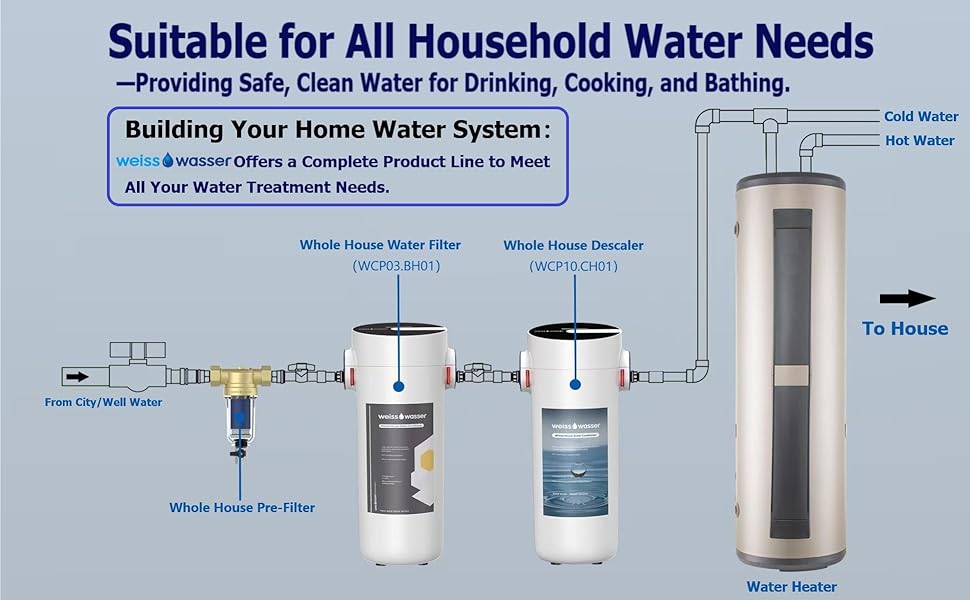The Necessity of Whole-House Multi-Stage Filtration Systems: Protecting Water Quality and Appliances

Access to clean water is vital for health, hygiene, and the longevity of household appliances. While single-stage water filters are common, they often fall short in addressing the diverse contaminants found in water supplies. A multi-stage whole-house filtration system—combining pre-filters, whole-house activated carbon filters, water softeners, and point-of-use (POU) purifiers—offers comprehensive protection. This article explores why a layered approach is essential for safeguarding water quality, reducing maintenance costs, and extending the lifespan of plumbing and appliances.
The Limits of Single-Stage Filtration
Single-stage filters, such as standalone activated carbon units or sediment filters, target specific contaminants but leave others unaddressed. For example:
- A sediment filter (e.g., PP cotton) removes sand and rust but fails to eliminate chlorine, heavy metals, or microbes.
- An activated carbon filter adsorbs chemicals and odors but cannot soften water or block fine particles.
- A water softener addresses hardness minerals (calcium, magnesium) but does not filter sediments or pathogens.
Key drawbacks of relying on a single unit:
- Rapid Clogging: A standalone filter faces concentrated contaminants, leading to frequent replacements.
- Partial Protection: No single technology can tackle all contaminants (particles, chemicals, microbes, hardness).
- Strain on Appliances: Unfiltered contaminants like sediment, limescale, or chlorine accelerate corrosion and damage to pipes, water heaters, and washing machines.
How Multi-Stage Filtration Works
A well-designed whole-house system combines complementary technologies in stages:
1. Pre-Filtration (First Line of Defense)
- Role: A sediment pre-filter (5–20 microns) traps large particles like sand, dirt, and rust.
- Benefits:
- Protects downstream filters and appliances from clogging or abrasion.
- Extends the lifespan of subsequent stages (e.g., carbon filters, softeners).
2. Whole-House Activated Carbon Filtration
- Role: A granular or carbon block filter adsorbs chlorine, volatile organic compounds (VOCs), pesticides, and odors.
- Benefits:
- Improoves taste and odor of water for all household uses (showering, cooking, laundry).
- Protects appliances (e.g., dishwashers) from chlorine-induced corrosion.
3. Water Softener
- Role: An ion-exchange resin replaces hardness minerals (calcium, magnesium) with sodium ions.
- Benefits:
- Prevents limescale buildup in pipes, water heaters, and coffee makers.
- Enhances soap efficiency, reducing detergent use and preserving fabrics in laundry.
4. Point-of-Use Purification (Final Barrier)
- Role: A reverse osmosis (RO) or ultrafiltration (UF) system at the kitchen sink removes residual contaminants (e.g., heavy metals, microbes, dissolved salts).
- Benefits:
- Delivers safe, high-quality drinking and cooking water.
- Complements upstream stages by addressing contaminants they cannot remove.
Why Multi-Stage Systems Outperform Single Units
- Distributed Workload: Each stage tackles specific contaminants, reducing the burden on individual units.
- Example: A pre-filter traps sediment, allowing the carbon filter to focus on chemicals, which in turn extends the softener’s resin lifespan.
- Comprehensive Contaminant Removal:
- Sediment → Chemicals → Hardness → Microbes/Dissolved solids.
- No single contaminant group overwhelms the system.
- Cost Efficiency:
- Fewer replacements: Pre-filters and carbon units last longer when protected by upstream stages.
- Lower repair costs: Appliances like water heaters and washing machines suffer less damage from scale or corrosion.
- Enhanced Water Quality:
- Softened water prevents dry skin and dull laundry caused by hardness.
- Chlorine-free water protects hair, skin, and rubber seals in appliances.
Real-World Impact on Households
- Plumbing Systems: Reduced scale and corrosion minimize pipe leaks and blockages.
- Water Heaters: Softened water improves heating efficiency and extends lifespan by 30–50%.
- Laundry and Dishwashers: Scale-free water prevents detergent residue and keeps appliances running smoothly.
- Health Benefits: Multi-stage systems reduce exposure to chlorine byproducts (e.g., trihalomethanes), heavy metals, and pathogens.
Conclusion: Invest in Layers, Not Just a Single Solution
A whole-house multi-stage filtration system is not a luxury but a necessity for modern households. By combining pre-filtration, carbon adsorption, softening, and point-of-use purification, such systems address the full spectrum of water quality issues while shielding appliances from premature wear. Single-stage units, though cheaper upfront, incur higher long-term costs due to frequent replacements and appliance repairs.
For homeowners, the message is clear: layered filtration ensures cleaner water, healthier living, and lasting savings. Whether your priority is protecting a costly espresso machine, preventing itchy skin after showers, or ensuring safe drinking water, a multi-stage system delivers holistic protection that no single filter can match.
By adopting this proactive approach, households not only enhance their daily water experience but also contribute to sustainable water management—one less clogged pipe or replaced appliance at a time.
